RECOIL OFFGRID Transportation Stealth Overlanding Rig
In This Article
Overlanding seems to be garnering a larger following every year. This demand has led to an increasing amount of product specifically tailored for vehicle-based recreation making its way onto the market. Ranging from trailer hitch stoves and inside-the-cab refrigerators to adjustable suspension and rooftop living quarters, there is something for everyone in the overlanding space. There's also an undeniable convenience to overlanding that traditional overnight camping just can’t match. Rather than parking, unpacking, tediously dragging all your gear to a campsite, and assembling your tent, the vehicle itself becomes a mobile living quarters and supply depot.
If this sounds appealing to you, you’re not alone. Not only can you explore greater distances, but many of the modern amenities we have all become used to — such as a refrigerator, stove, and running water — can be replicated and mobilized. This opens the world of outdoor adventuring to a wider range of people, including the young, elderly, and physically challenged. Without needing to carry everything on your back, you’re free to take in those panoramic views sans laborious breathing and muscle fatigue. This makes exploring the outdoors behind the wheel of a vehicle exciting and safe if done properly.
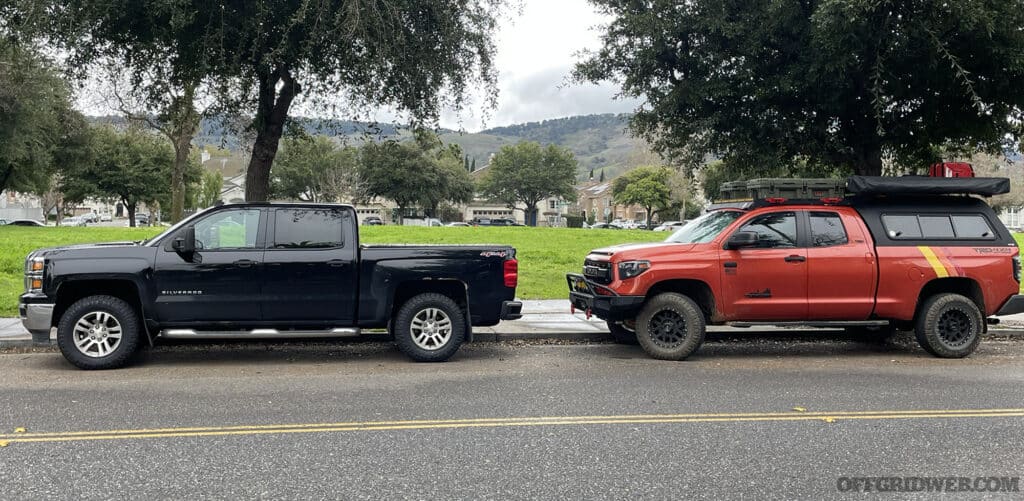
Above: Both of these vehicles are built for overlanding. However, one definitely stands out more than the other.
There is also a preparedness component to overlanding. Sure, living out of your vehicle is a fun and convenient way to camp, but what about situations that force you to leave the comforts of your own home? Every year, natural disasters like fires, hurricanes, and earthquakes force people to flee from their homes in search of safety. Civil unrest and war displace thousands on a regular basis. Having a mode of transportation that can also provide temporary living conditions would be beneficial in these situations.

Unfortunately, for anyone who doesn’t have a garage or land to work on or store a vehicle, overlanding may seem out of reach. Nobody wants to pour money and time into a project like overlanding, only to have thieves or criminals break in and steal all that hard earned equipment.
Sadly, in many places across the US, simply having an item as innocuous as a blanket lying in the back seat is an invitation to smash a window. But that doesn’t mean overlanding has to be an impossibility. In fact, building a minimalistic overlanding rig that doesn’t attract attention is a great way to get started, and saves a few bucks while doing so. As a fellow urbanite, this is exactly what I set out to do.
Choosing an overlanding vehicle can seem overwhelming, since there is a ton of debate as to which is the best choice. Certainly some are better equipped for the job than others. Starting out with a popular platform like a Ford Ranger or Toyota 4Runner will put you ahead in capabilities compared to a sedan. However, it is often said that the best tool is the one you have.
Rather than buy an entirely new vehicle for the project, I decided to save that money by keeping what I already owned: a 2014 Chevy Silverado. This is a vehicle I picked up at a discount due to high mileage years ago. Historically, previous owners used it as a work truck, and I used it for work as well. It has more than a few dings, scratches, and rust spots. It may not win any awards for good looks, but the price was right, and it has a ton of overlanding capability built in.
Many people tend to go to extremes when building an overlanding rig, especially if they intend to climb boulders or tackle challenging trails. But for someone who just wants to go camping occasionally or be able to get out of Dodge (no pun intended) in an emergency, most trucks and SUVs come stock with a lot of useful features.
Having an AWD or 4X4 vehicle is a great starting point, since having this capability will get you out of common dicey situations, especially if you plan on sticking to roads or more permanent trails. The Silverado comes equipped with 4-wheel drive and a towing package, which is more than enough to handle most tasks. It can cope with wet roads, moderate snow, sand, and mud, even without specialized modifications.
While the stock features will get you out of a jam during normal driving conditions, it is nice to augment those capabilities when you purposefully deviate from paved roadways. If minimalistic is the name of the game, it becomes easier to make upgrade decisions. Everything boils down to selecting parts that help give performance a boost, but do not stand out visually.
Unless your vehicle came off the lot with an off-road package, you’re probably driving on tires made to eliminate road noise, and riding on a suspension with okay (but not great) ground clearance, as was the case with my Silverado. Additionally, my truck’s suspension came adjusted so the front looked slightly lower than the back. This is so it levels out when you load the back with extra weight, but the lower front end doesn’t make it ideal for traversing rocky trails or navigating over obstacles.
To give my ground clearance a little extra boost, and make climbing over terrain easier, the first upgrades made to the Silverado was a leveling kit and new tires. The one I used from Rough Country raised the front 2.5” which allowed me to add new tires that were slightly larger (about another 2”) than my original road tires. Nitto Ridge Grappler’s were my tire of choice, both for their quietness on the road, and their more aggressive tread.
The combination of tires and leveling kit gave the Silverado about another 4” of ground clearance, raising it to ~12” overall. This is more than enough clearance to climb over most obstacles and debris found on backcountry roads and prevent getting bogged down in mud. Nitto’s Ridge Grappler tire tread strikes a good balance between quiet comfort and improved traction in sand, snow, or wet conditions. Most of all, these upgrades do not stand out when it is parked next to a curb outside.
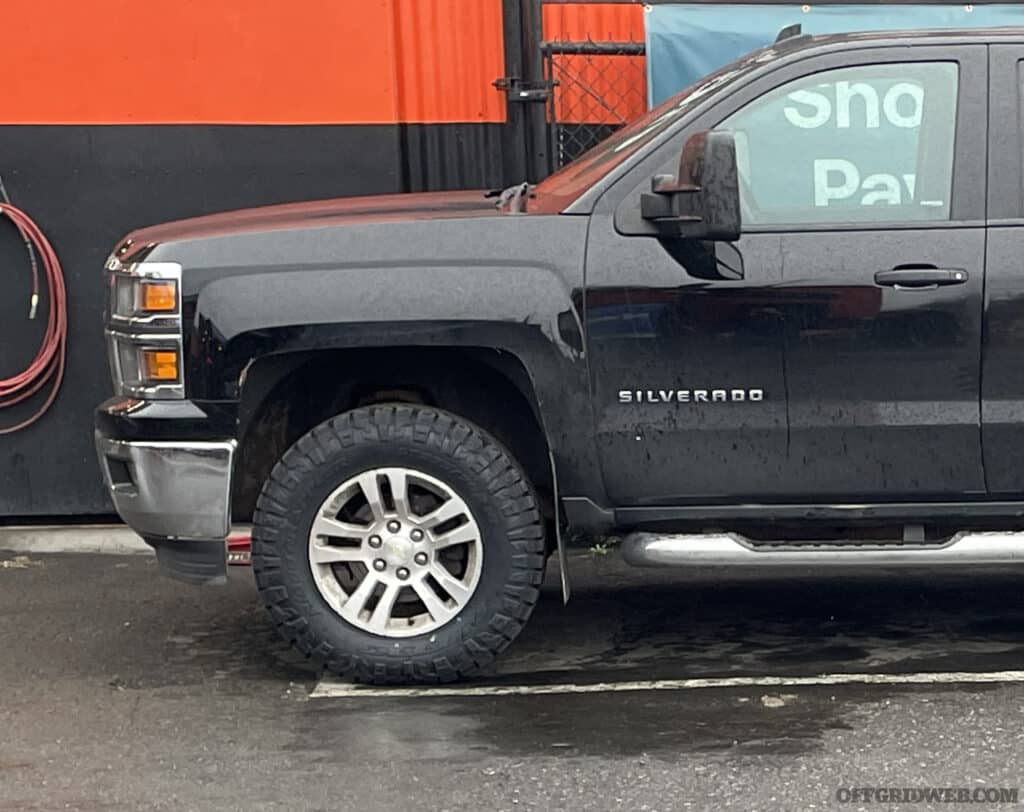
Above: Installing a simple leveling kit and only slightly larger tires gives the truck a few more inches of clearance, without the “monster-truck” appearance of some hardcore overlanding rigs.
Seeing well at night is crucial when navigating challenging terrain, but some light upgrades will tell everyone that you’ve invested money into your vehicle. Rather than advertise my gear to potential thieves by installing a myriad of light bars and spotlights all over the place, I decided to go a more subtle yet effective route. By replacing the factory halogen bulbs with high-power LED headlights, I can achieve similar results as an externally mounted light source can.
One downside to not mounting a light externally, is that you cannot illuminate much to the sides of the vehicle, making narrow roads a night more precarious to traverse. This is why so many overlanders install ditch lights or wide-angle fog lights. But the illuminated, forward-facing direction of travel is greatly improved with the upgrade. In addition to the headlights, I also installed truck bed LED lighting, since this is where I’ll be storing gear and sleeping.
Externally, the stealth overlanding build is looking nondescript, which is the easy part. Getting all the essential overlanding gear stored without becoming the target of theft is much trickier. To accomplish this, I made use of the Silverado’s already existing storage options, as well as a few addons. For starters, both glove box compartments, and a compartment built into the front bench seat are lockable. These are perfect for handheld devices and other smaller valuable items.
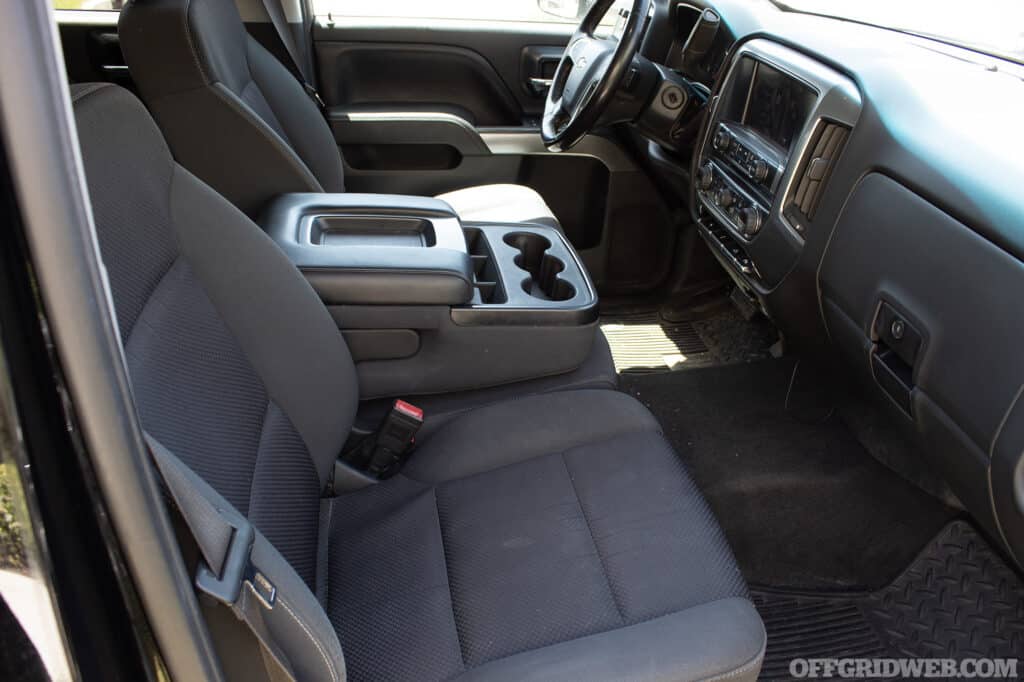
Above: When looking into the front seat, there is no indication that this truck contains anything that could be used for overlanding purposes. The absence of things to steal is a break-in deterrent.
Storage
Headrest Safe was my choice to store a handgun for self-defense purposes. These come in a multitude of upholstery options to blend into the vehicle's existing color scheme. They can also be paired, so each seat has the same headrest design to avoid one from looking completely different from the other. Quick adaptors included with the kit make installation a breeze once the original headrests are removed. The safe itself can be programmed with a 4-digit pin, or fingerprint for quick access, and is large enough to accommodate a full-size handgun.
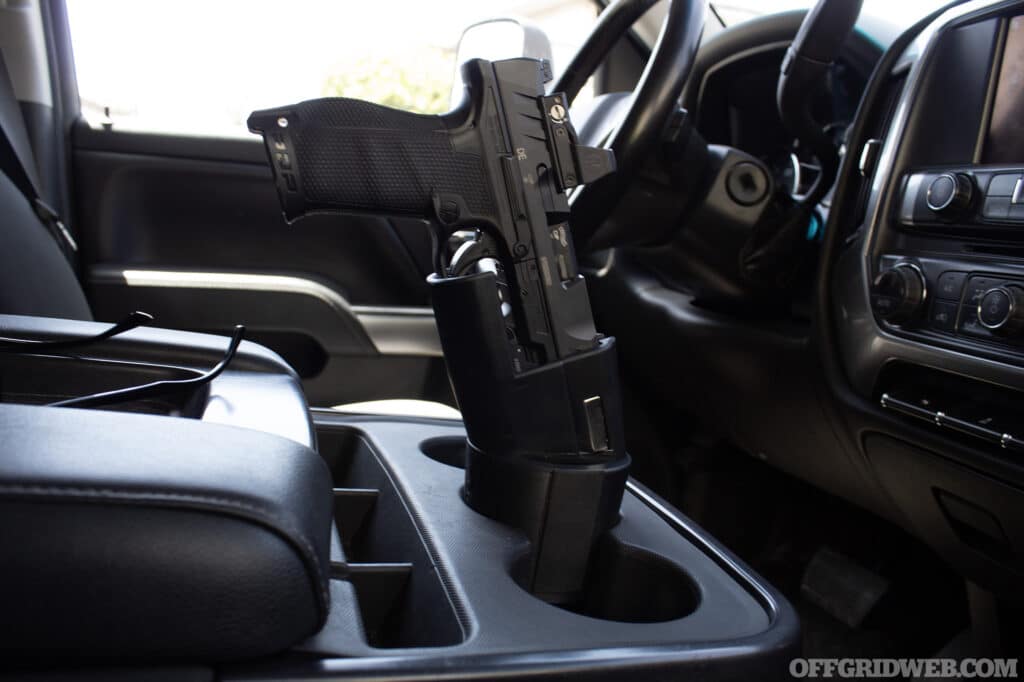
Above: In high threat environments, the use of a Cupolster is a convenient way to have a handgun at the ready.
For recovery gear, first aid equipment, or even a rifle or shotgun, I installed a Tuffy Lockbox under the bench seats in the back of the crew cab. Typically, I would just toss items under the seat and call it a day, but anyone intent on breaking in may catch a glimpse of something and feel the temptation to steal. With the Lockbox, I have over 3500 cubic inches of lockable storage space that fits perfectly under the seats.
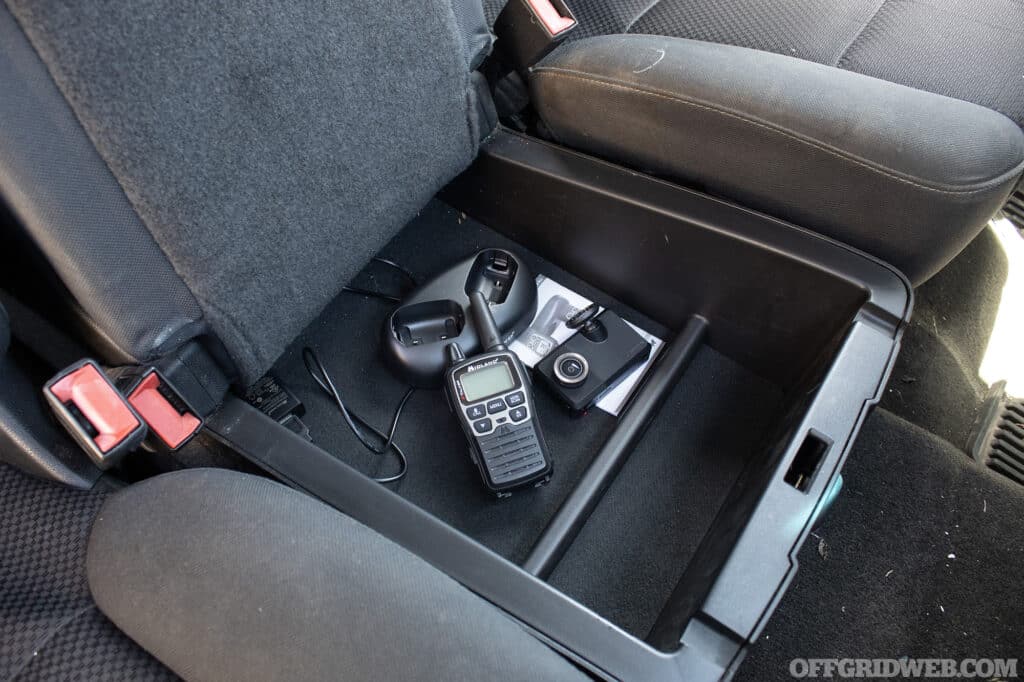
Above: The locking storage space under the front bench seat is a handy place to store radios, dash cams, and other items that need to be easily accessible by the driver.
Communication
Installing a dedicated CB or GMRS radio on the dash is out of the question, since its presence would be too obvious that the truck might have more than meets the eye. However, having a means of communication beyond a cell phone is a must for several reasons. First, a lot of overlanding is done in remote regions where cellular coverage may be spotty or nonexistent. Another important reason for reliable two-way comms is if you have to work with a spotter outside the truck to navigate over difficult terrain.
To ensure that I have a backup means of communication, I turned to Midland, which is renowned for their emergency radios. Their X-Talker line of radios not only provides long-range walkie-talkie capabilities, it is also programmable, can incorporate privacy codes, and has a built in weather alert to keep the user abreast of important announcements.
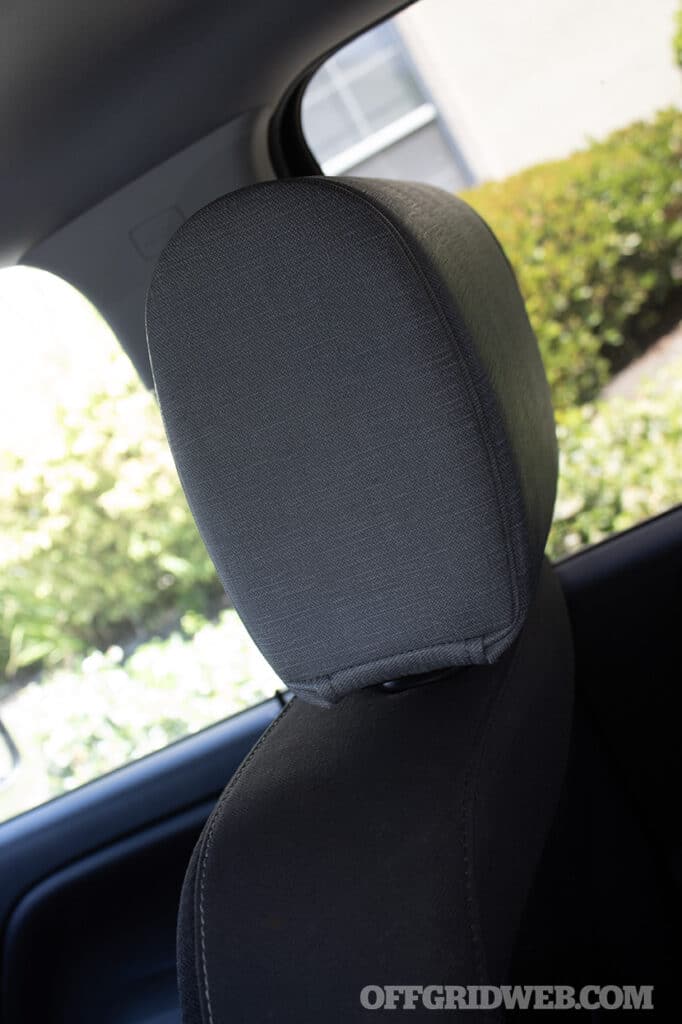
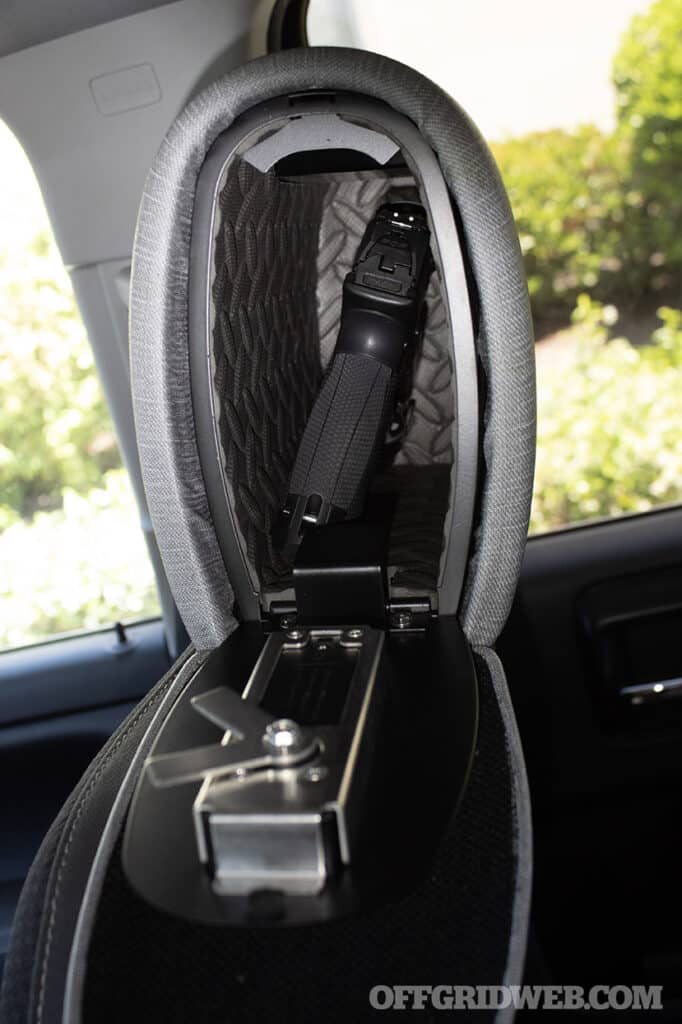
Above: Headrest Safe provides secure storage for many handgun styles like this full size 5″ Walther PDP. They also offer upholstery matching, and an identical headrest so one doesn't look different than the other.
Navigation
Being able to get from point-A to point-B accurately and safely is probably the single most important task during an overlanding trip. This makes maps and navigation tools an essential item. These days, everyone has a pretty decent GPS built into their smartphones, but nothing is more annoying than not being able to view the mapping app comfortably when it's needed.
The Silverado is notoriously difficult to find an appropriate phone or GPS mount. Because of the steering wheel and column shift control locations, using vent clips or dashboard mounts almost never works out the way you want it to. This means finding a window mount that will hold up to getting jostled while driving on rougher ground. After much trial and error, I came across Nite Ize, which has a window mount and uses a powerful magnet to keep the phone holder in place.
In addition to the phone's GPS and whatever mapping app I decide to rely on, I also have a backup GPS in the form of a handheld Garmin. The great thing about the Garmin is its inReach capability for emergency situations.
Just in case the worst occurs and I’m left without power, I throw a printed National Geographic Road Atlas into the Tuffy Lockbox. This has all the features a normal road atlas, with a special focus on parks and recreation.
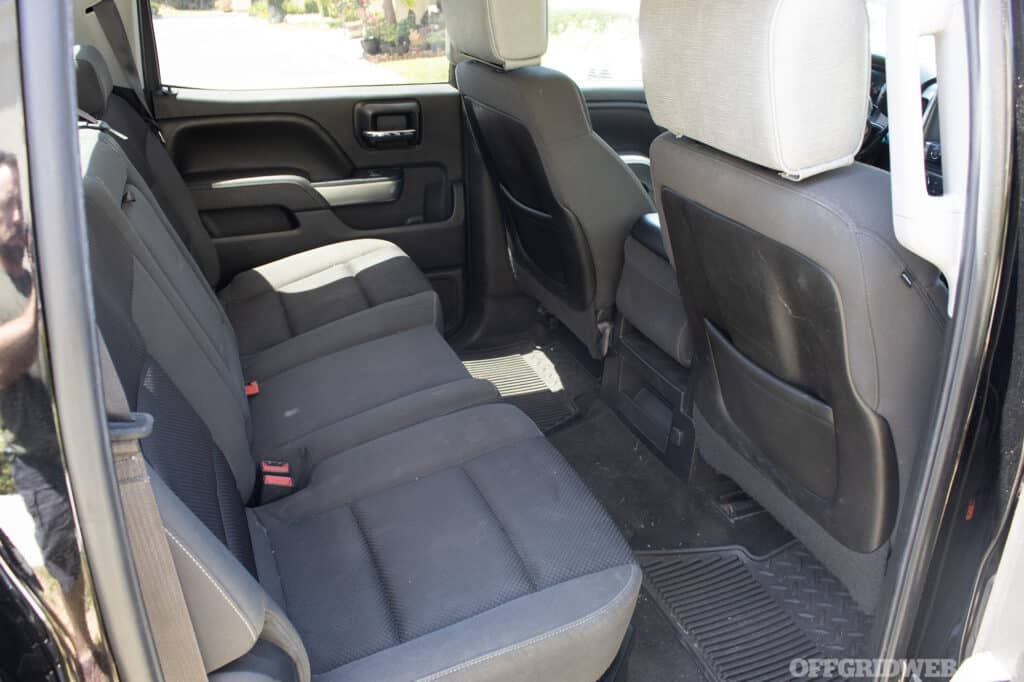
Above: When everything is stowed in the back, nothing stands out that would make a passerby think it contains overlanding gear.
Recovery
The ability to self-recover is a must when spending any time in the backcountry. It’s one of those scenarios no one wants to encounter, but when you do, the right contingencies can turn expensive recovery operations into a minor inconvenience. To start, I make sure that I have a full-size spare that matches my existing tires. Not using a full-size spare can make for an awkward drive if you have to use it. It’s important to make sure that the spare is full of air before heading out.
I’ve also included a tire repair kit to fix punctures, and a portable air compressor to refill wherever I happen to be. Just in case I need to be extracted — or help someone else get out of a jam — I have a tow strap rated for 15,000lbs, and a Bolt Receiver Lock to keep any trailer hitches from wandering off if I’m hooked up to something overnight. For traversing those late-season mountain passes, I’ve included a set of snow chains for the front tires.
Lastly, recovery in the dark is tricky and dangerous without appropriate lighting, so I’ve added a Streamlight headlamp and NexTorch spotlight. These lights also double as a way to illuminate a campsite or signal for help.
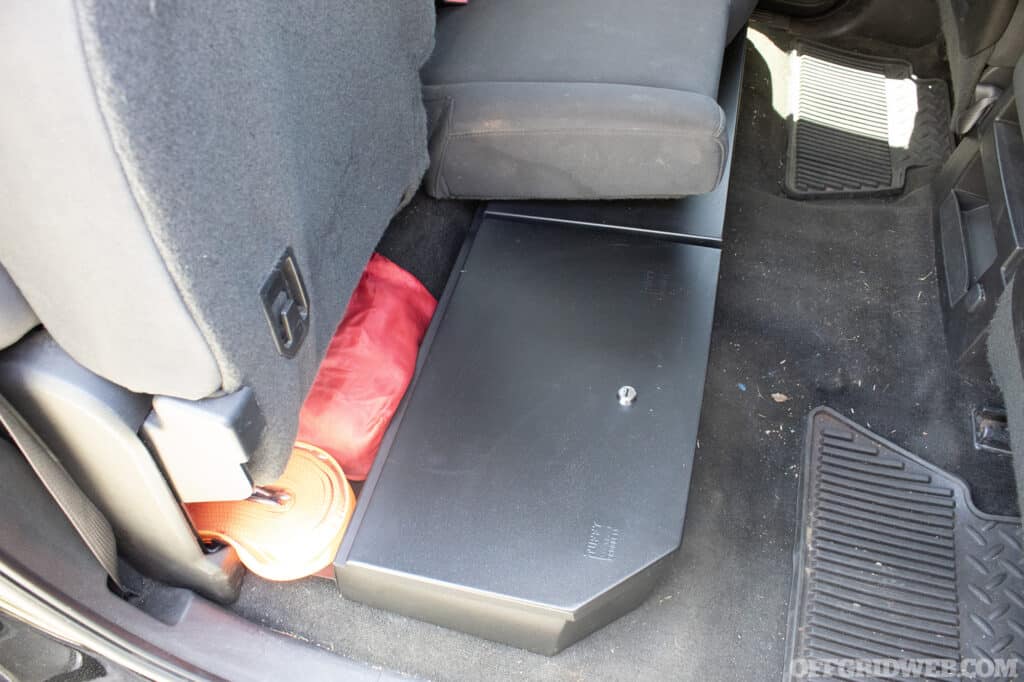
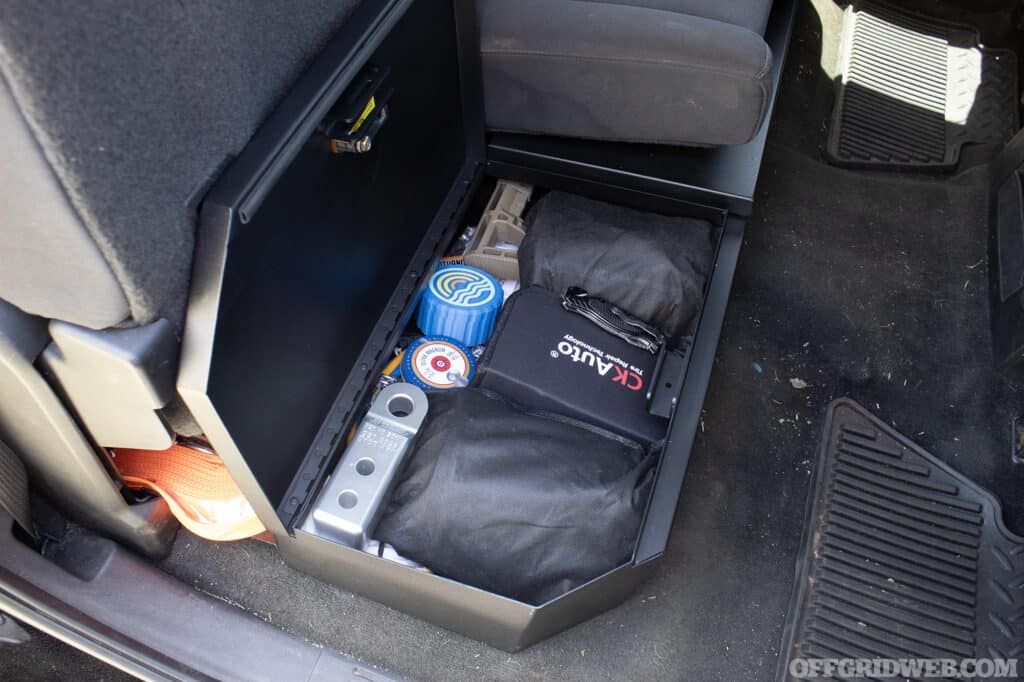
Above: The Tuffy Bench Locker is a secure way to stow recovery gear and other essential items.
Defense and Sustenance
One aspect of the stealth overlander's ability to ward off trouble is the inclusion of a Garmin Dash Cam. When the Silverado is parked somewhere, the dash cam sends notifications via mobile app to alert the user when it detects sound, movement, or motion near the vehicle. This allows you to keep close tabs on your rig if you’re traveling through an area that might be prone to vehicular crimes. It can also be a great source of evidence in the unfortunate event of a crash or hit and run.
Heading out into the wild regions of the world poses dangers beyond crime and rough terrain. Predatory animals and untrustworthy strangers abound. In the headrest safe, I keep my Walther PDP, and I also have a Cupolster from Vets Tactical in one of my glove boxes, in case I want to keep my handgun off-body but nearby and ready to go. Beyond defense, getting some grub is another task that could come in handy in a pinch. In the back seat Lockbox I keep a GoReel for some impromptu fishing, and a Black Bunker air rifle for varmints if I think I’ll be off the grid for an extended period of time.
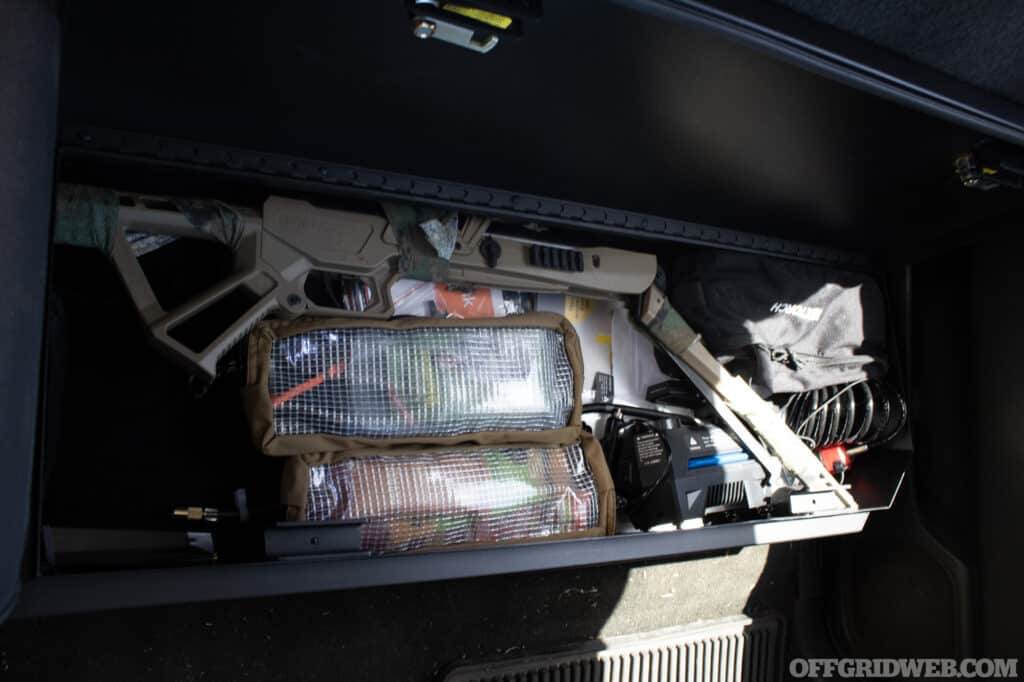
Above: The bench locker is a great place to store other provisions, like food, maps, or a an air rifle like the Black Bunker BM8.
First Aid and Hygiene
Items used for treating injuries and staying clean are another often overlooked necessity. Having a well-stocked IFAK ensures that I’ll have a tourniquets for traumatic injuries and enough supplies for minor cuts and scrapes. In the bed of the truck, I keep a 5-gallon bucket with a toilet lid for when nature calls, along with some TP, wet wipes and hand sanitizer. I also bring at least 5-gallons of potable water, not only for staying hydrated, but for staying clean in the field.
Where I (and many others) in the US live, there is a very real risk of wildfires during the dry summer months. Having driven through the smoke of a large burn before, I know all too well how important it is to be able to breathe clean air. To help mitigate the dangers of smoke inhalation, I’ve include two full-face respirators with filters rated for smoke particles.
Beyond the necessities, overlanding is an individual and personalized experience. Some folks like to rough it with minimal gear, others like a more extravagant “glamping” experience. But for the sake of staying stealthy, I keep almost everything I’ll need in a tote that I can easily grab from storage and throw in bed of the truck. This includes things sleeping bags, mess kits, freeze dried food, a hand-pumped shower, and an inflatable air mattress specifically designed to fit the Silverado’s bed.
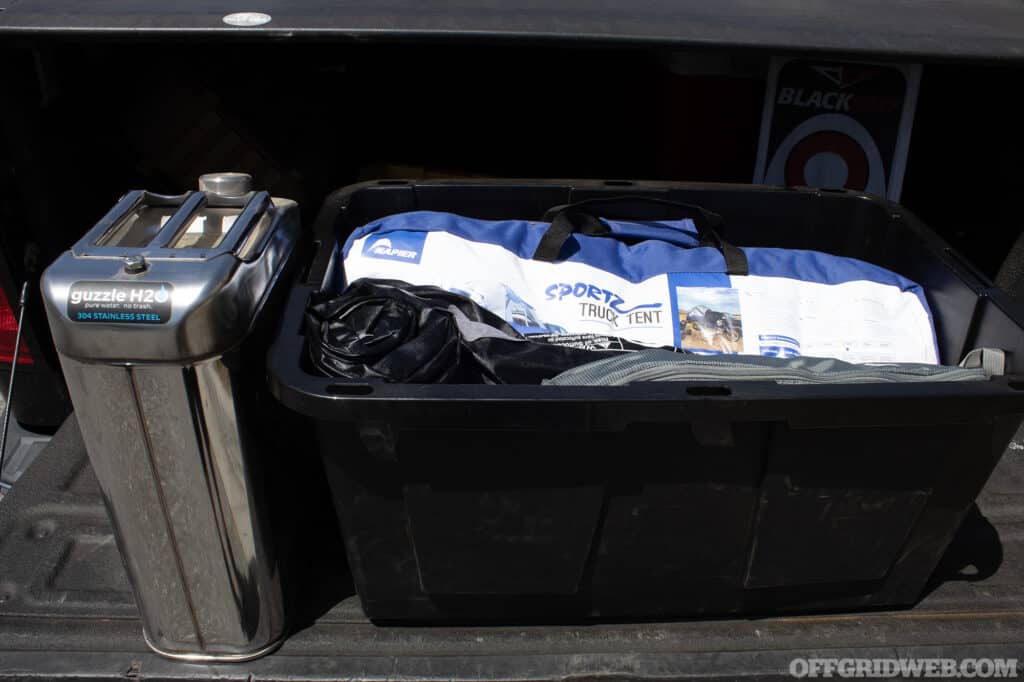
Above: With a Costco tote and a 20L water can, bugging out is as quick and easy as tossing a few items in the bed of the truck.
Whatever is placed in the back, it's meant to be loaded relatively quickly and compact enough that it remains concealed beneath the Silverado’s tonneau cover. Depending on my expected overlanding duration I might tweak the contents to one of the following configurations:
The Weekender Loadout
In most cases, I’ll probably just want to go enjoy the wilderness for a day or two on the weekend, which means I won’t need much beyond what I already have. For this, I’ll use the Napier Sportz Truck Tent, which is fast to set up, lightweight, and great for a hot summer trip. The goal of this load out is to be a grab-and-go setup, something you wouldn’t have to overthink, or plan too far in advance. As such, the weekender loadout is ideal for getting out of Dodge in an emergency situation.
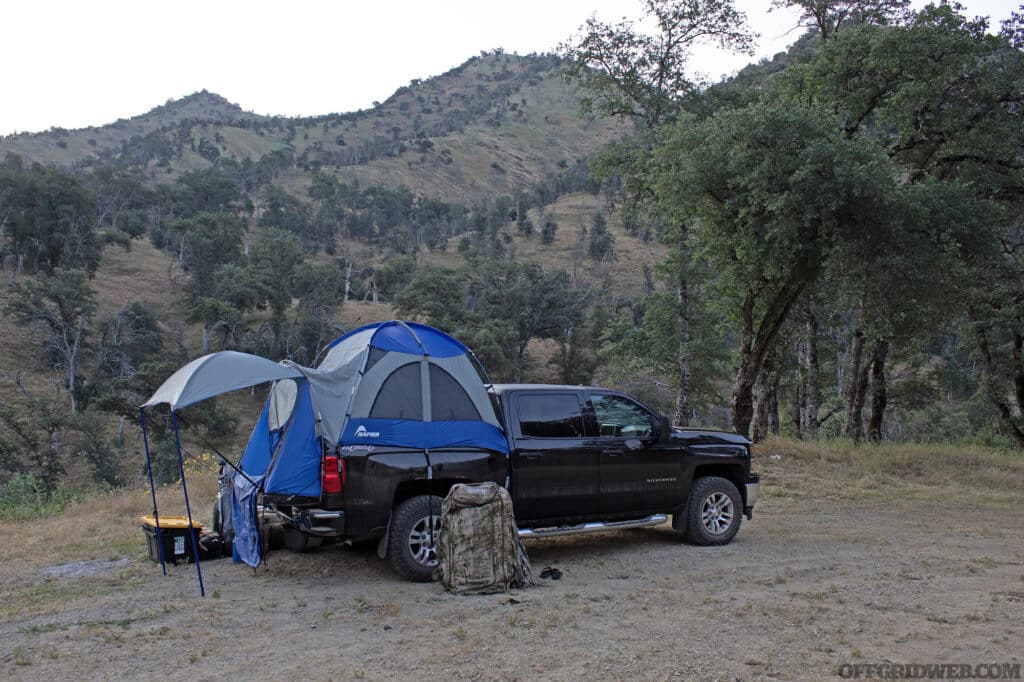
Above: Napier's nylon tent is light-weight and easy to set up quickly.
The Expedition Loadout
For overlanding trips longer in duration, or for trips in colder weather, I’ll tweak the contents of the loadout to be more robust. This includes swapping the nylon tent out with a Kodiak Canvas Truck Tent, bringing a small propane grill, a Stihl chainsaw, some axes, a buck saw, and some more serious cast-iron cookware. For fun, I can also include a Kokopelli inflatable watercraft. Since the items of this loadout are more suited to long-term camping, it makes a great setup for hunting trips.
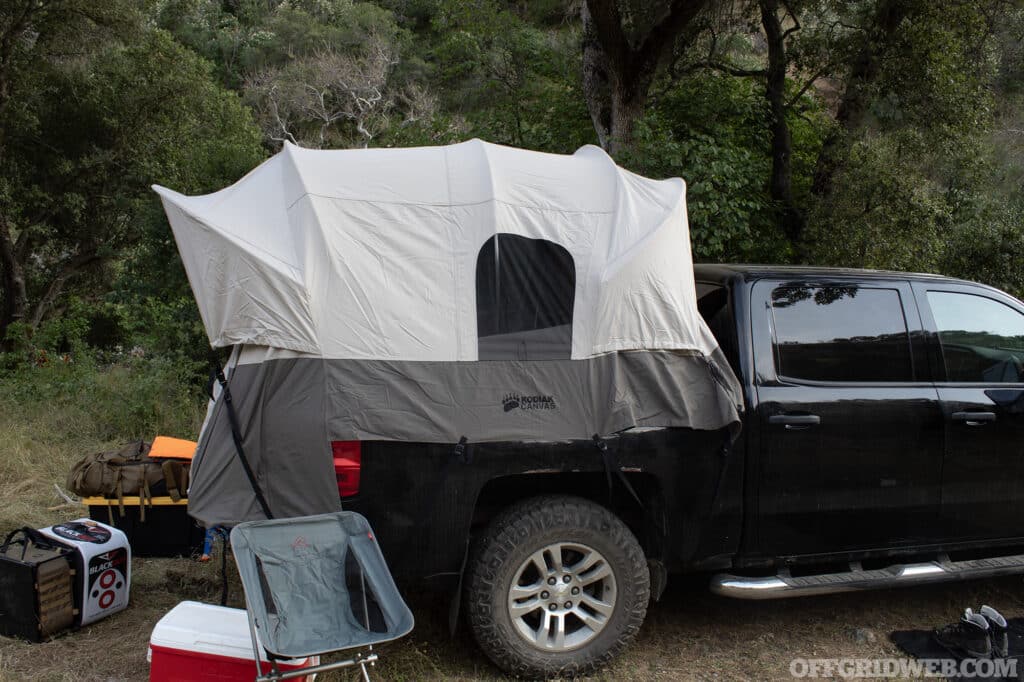
Above: Canvas is great for longer durations, doesn't trap moisture like nylon, and is strong enough to withstand the weight of snow.
Total: $7,619!
When it is all pulled together and fully loaded, my stealth overlanding rig looks just like an empty truck parked on the side of the road. But in a moment’s notice, I can hop in, head out, and know that it can handle most challenges. Without accounting for the addition of firearms, the entire set up is close to $8000, including the $1000 I spent to have a garage install the leveling kit and tires.
It’s not uncommon to spend tens of thousands, even on a “low budget” build, so keeping it under $10k is a pretty big deal. Since completion of the stealth overlander, the Silverado has been parked in one of the most densely populated urban centers in the U.S. without a single break-in, proving the concept is effective.
One of the most important lessons I learned while putting this build together is that by focusing on the essentials, overlanding is relatively accessible. Everything beyond the essentials is highly individualistic and situationally dependent, which means you can focus on what really matters to you. Sure, it doesn’t have adjustable suspension, a built in mini-fridge, or an overly posh sleeping arrangement, but it will get me on some rugged trails and enjoying the great outdoors whenever I feel inclined to do so. All without breaking the bank, or tempting a low-life to pillage my gear.
Subscribe to Recoil Offgrid's free newsletter for more content like this.
Editor's Note: This article has been modified from its original print version for the web.
 STAY SAFE: Download a Free copy of the OFFGRID Outbreak Issue
STAY SAFE: Download a Free copy of the OFFGRID Outbreak Issue
No Comments